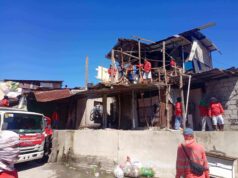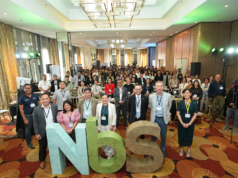Already hailed as Southeast Asia’s grandest, leaving its Clark forebear by the proverbial mile, the Pradera Verde up-up-andaway- to-the-blue-yonder extravaganza makes more experience – of the most delightful kind, than mere spectacle – the awe it inspires, notwithstanding.
The timing of the balloonfest this year though – abutting at Viernes Dolores onto Domingo de Ramos – gives one some thoughts on its locus, consequently, of the spiritual kind.
Of the many things Lubao is – hometown of two Philippine presidents, foremost – little is known of its being the fountainhead of Catholicism in Pampanga, streaming up the central plains and northern mountain ranges.
A timely re-think of Lubao this Holy Week, this Zona Libre piece of May 8, 2012.
WHY LUBAO?
Of all settlements in the backwaters, plains and hinterlands of Pampanga, what made the trailblazing Augustinian friars in 1572 to choose Lubao to be the nexus of the Catholic faith not only in the province but up and across the expanse of the central and northern regions of Luzon?
Asked the Most Rev. Pablo Virgilio S. David, auxiliary bishop of San Fernando, in his homily in the High Mass celebrating the 440th year founding of the St. Augustine parish last May 5.
Low-lying and thus prone to flooding, notwithstanding –its very name taken from bajo, Spanish for low – there was something in Lubao that the Augustinians found of great significance: the people, mostly farmers and fisherfolk, of humble birth and bearings, comprising a balayan ning kababan, locus of humility, the good bishop said. Where most manifest one core value of the Faith.
“Blessed are the meek, for they shall inherit the earth.” The second of the Eight Beatitudes, Matthew 5:5. Reflected I, listening to Among Ambo.
Thus by its lowliness, less geographic than anthropologic, Lubao rightfully took its place as the fountainhead of Catholicism for the Kapampangan race.
Delving on the gospel for that day, Matthew 16:18-19 – “And I tell you, you are Peter, and on this rock I will build my church, and the gates of hell shall not prevail against it. I will give you the keys of the kingdom of heaven; whatever you bind on earth will be bound in heaven, and whatever you loose on earth will be loosed in heaven” – the good bishop continued with the celebrated place of the lowly in the City of God, to use the word of St. Augustine.
With Peter as perfect example, in transcending his human frailties and imperfections with his innate humility.
And but of course, Lubao’s patron saint himself, St. Augustine of Hippo whose mother St. Monica – as tradition holds – cried buckets of tears for the conversion of her sinful son.
“But I wretched, most wretched, in the very commencement of my early youth, had begged chastity of Thee, and said, ‘Give me chastity and continency, only not yet.’” Thus, St. Augustine in his Confessions.
The bishop’s sermon and personal reflection intertwining, and with the once nearphotographic memory faded with age, retained now are but snatches of the homily, the opening and concluding part coming full circle though. (How I wish I had the full text of Bishop Ambo’s homily and simply reprinted it here. No word by me can ever approximate even but a fraction of the brilliance, of the eloquence of my once underclassman at the Mother of Good Counsel Seminary. And to think that he delivered his homily from a mere outline!)
For over a thousand years now, the El Camino de Santiago (The Way of St. James) in Spain has drawn from all over Europe thousands of pilgrims on foot, on horseback, on bicycles – never on motorized vehicles, converging on the magnifi cent Santiago de Compostela Cathedral where St. James is buried.
Why do they do it?
The pilgrimage is a return to their roots, the burial site of St. James serving as the fountainhead of Christianity in Europe.
Finding parallelism there, the good bishop broached the idea of an El Camino a Lubao (The Way to Lubao) or an El Camino de San Agustin (The Way of St. Augustine) to afford every Kapampangan a return to the very roots of his/her Faith. From the wetlands of Candaba and Masantol, from the highlands of Porac and Floridablanca, from the urban centers of Mabalacat and Angeles City the Kapampangan faithful, whether in penitence and supplication, or in thanksgiving and veneration, walking the highways and byways to the St. Augustine Parish Church in Lubao.
The grace of a pilgrimage, a refreshing renewal in one’s Faith if only once in one’s own lifetime makes a truly blessed experience.
Ah, I can almost hear St. Augustine beckoning: “You have made us for yourself, O Lord, and our hearts are restless until they rest in you.”
The way of St. Augustine. The path to conversion. The road to salvation. O, that we may all be blessed to take it.
…AND TAKE us, in turn to that spiritual high, that no hot air balloon can even aspire to reach.



